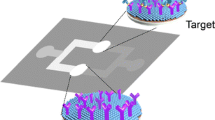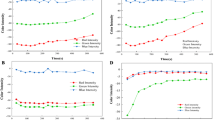Abstract
This is a one-step POC biosensor that guarantees rapid assay times, low-cost analysis, simple handling, stability, and is easy to mass product. However, it has several drawbacks such as limited sample volume and relatively low sensitivity. To overcome these disadvantages, we have designed and fabricated the µ-PAD to confine fluid flow by creating a hydrophobic channel in the paper to improve the sensitivity. The channel pattern was drawn by a computer-aided design program and directly printed by a commercially available wax printer which generates the hydrophobic channel pattern. While maintaining a constant sample, absorption, and conjugation pad, the width of the detection pad was reduced from 5 mm to 2 mm at intervals of 1 mm. The intensity of bands from the single- and double-orifice patterns increased identically compared with the device with no orifice. The relative intensity of the signal bands increased from 141 to 158. Also, numerical simulation was performed to validate the experimental result by using lattice Boltzmann method. We observed that the sensitivity was enhanced at a specific detection pad width (3 mm). Therefore, our simple structural change of the channel led to improve the colorimetric intensity. Cortisol, which is a known stress biomarker, was used to validation the device, an enhanced signal was obtained indicating that our device can be used for the detection psychological stress in humans.
Similar content being viewed by others
References
Hu, J. et al. Advances in paper-based point-of-care diagnostics. Biosens. Bioelectron. DOI 10.1016/j.bios.2013.10.075 (2014).
Novak, M.T. et al. Diagnostic tools and technologies for infectious and non-communicable diseases in lowand- middle-income countries. Health. Technol. DOI 10.1007/s12553-013-0060-9 (2013).
Yetisen, A.K. et al. Paper-based microfluidic pointof- care diagnostic devices. Lab Chip 13, 2210–51 (2013).
Mace, C.R. & Deraney, R.N. Manufacturing prototypes for paper-based diagnostic devices. Microfluid Nanofluid 16, 801–809 (2014).
Fu, E. et al. Two-dimensional paper network format that enables simple multistep assays for use in lowresource settings in the context of malaria antigen detection. Anal. Chem. 84, 4574–4579 (2012).
Fang, C. et al. Barcode lateral flow immunochromatographic strip for prostate acid phosphatase determination. J. Pharm. Biomed. Anal. 56, 1035–1040 (2011).
Osborn, J.L. et al. Microfluidics without pumps: reinventing the T-sensor and H-filter in paper networks. Lab Chip 10, 2659–65 (2010).
Fu, E. et al. Chemical signal amplification in twodimensional paper networks. Sens Actuators B Chem. 149, 325–328 (2010).
Fu, E. et al. Enhanced sensitivity of lateral flow tests using a two-dimensional paper network format. Anal. Chem. 83, 7941–7946 (2011).
Ge, C. et al. An enhanced strip biosensor for rapid and sensitive detection of histone methylation. Anal. Chem. 85, 9343–9 (2013).
Parolo, C. et al. Simple paper architecture modifications lead to enhanced sensitivity in nanoparticle based lateral flow immunoassays. Lab Chip 13, 386–390 (2013).
Martinez, A.W. et al. Patterned paper as a platform for inexpensive, low-volume, portable bioassays. Angew. Chem., Int. Ed. 46, 1318–1320 (2007).
Martinez, A.W. et al. Three-dimensional microfluidic devices fabricated in layered paper and tape. Proc. Natl. Acad. Sci. U.S.A. 105, 19606–19611 (2008).
Martinez, A.W. et al. FLASH: a rapid method for prototyping paper-based microfluidic devices. Lab Chip 8, 2146–2150 (2008).
Lee, J.H. et al. Emotion-on-a-chip (EOC): evolution of biochip technology to measure human emotion using body fluids. Med. Hypotheses 79, 827–832 (2012).
Lee, J.H. & Jung, H.I. Biochip technology for monitoring posttraumatic stress disorder (PTSD). BioChip J. 7, 195–200 (2013).
Schmidt, H.D. et al. Functional biomarkers of depression: diagnosis, treatment, and pathophysiology. Neuropsychopharmacology 36, 2375–2394 (2011).
Singh, I. & Rose, N. Biomarkers in psychiatry. Nature 460, 202–207 (2009).
Leung, W. et al. One-step quantitative cortisol dipstick with proportional reading. J. Immunol. Methods. 281, 109–118 (2003).
Choi, S. et al. Economical and rapid manufacturing of lateral flow immunosensor using fountain pens and gold colloidal solution. Anal. Methods. 7, 1834–1842 (2015).
Hermanson, G.T. Bioconjugate Techniques, 1st ed. Academic Press, San Diego, CA. (1996).
Author information
Authors and Affiliations
Corresponding author
Rights and permissions
About this article
Cite this article
Choi, S., Lee, JH., Kwak, B.S. et al. Signal amplification in a microfluidic paper-based analytical device (µ-PAD) by confinement of the fluidic flow. BioChip J 9, 116–123 (2015). https://doi.org/10.1007/s13206-015-9204-5
Received:
Accepted:
Published:
Issue Date:
DOI: https://doi.org/10.1007/s13206-015-9204-5




